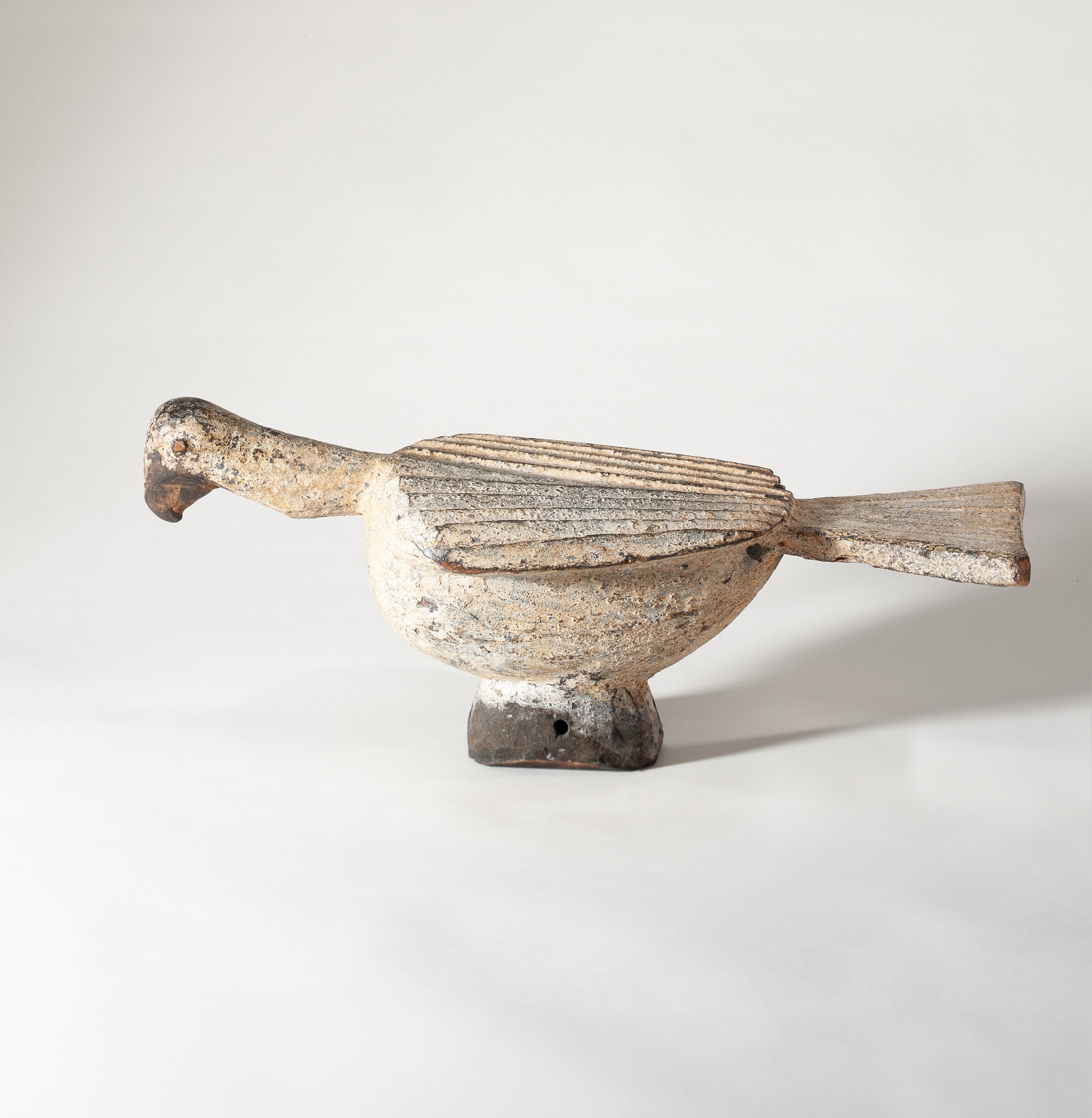
BIRD HEADDRESS
Anonymous Ijo artist
Nigeria, Early 20th century
Wood. 45 cm
Provenance:
Pierre Langlois, Paris, France
By descent through family, 2023
Native, Brussels, 14 December 2023, lot 86.
Duende Art Projects, Antwerp, Belgium, 2023

The Niger River forms the second largest – and the largest inhabited – delta in the world. The Niger Delta’s myriad rivers and creeks not only define a geographic region; they also from a cultural confluence. Its peoples, including the Ijo, Itsekiri, Isoko, Urhobo, Lagoon Yoruba, Riverain Igbo, Ekpeye, Abua, and Ogoni, overlap and mingle, drawn together by trade, intermarriage, and common interests. As diverse and distinct as they may be in terms of language, world view, and social organization, they have borrowed freely from each other. The Central and Western Ijo, who have historically depended on fishing and farming, often appear to have more in common with their Urhobo and Isoko neighbors than their Eastern Ijo relatives, who prospered as middlemen during the era of colonial trade. A recurrent theme in these Niger Delta cultures is water. Throughout the Delta – and well into adjoining mainland regions – people associate water and water spirits with well-being, fertility, and prosperity. The prominence of water and water spirits in the region’s masquerades is thus not surprising. The Ijo term for both the spirits and masquerades that represent them, owu, describes a masking complex that stretches from the Yoruba lagoons well into the Igbo area, far to the east. Many of the groups in this complex use horizontal-oriented masks derived from Ijo prototypes, but some, like the Urhobo and Isoko, have retained their own mask types while clearly basing their performances on Ijo models. While we’ve attributed this bird headdress to the Ijo, somehow similar examples have been observed among neighboring groups.

A trio of umale (water spirit) masquerades – typical for the Itsekeri urban social clubs. The spirit in this case is Okpekuru, which is also the name of the fish on the headdress. Photographed by D. Anthony Mahone in Warri, 1994. Published in: Anderson, Martha G. and Philip M. Peek (eds). 2002. Ways of the Rivers: Arts and Anderson (Martha G.) and Philip M. Peek, “Ways of the Rivers: Arts & Environment of the Niger Delta”, Los Angeles, UCLA, 2002, p. 32, fig. 13.
The Ijo share the rivers that dominate their environment with beings they call the “Water People” and they pay tributed to these quasi-human spirits in their masquerades. A myth from the Kalabari area, the eastern Ijo city-state whose masquerades are best documented, tells how a woman abducted by water sprits returned to teach her townspeople the plays she had seen beneath the water. A cycle consisting of from thirty to fifty masquerades is performed by each village in the Kalabari city-state. Every masquerade has its own distinctive headdress, costume, drum rhythm and dance steps. An expert dancer impersonates the spirit, inducing it to enter and control his movements. A headdress as the present would be worn as a headpiece, the lower section attached to large pieces of cloth, obscuring the dancer’s head and body. Perhaps surprisingly, birds also appear in these water spirit masquerades, yet are much less common than aquatic animals. For the Kalabari Ijo, these birds are probably references to oru ogolo, the talkative bulbul bird that is said to live in villages and to speak the language of the spirits. It communicates messages from the spirits to humans. Other may depict the fishing eagle, for eagle feathers are worn by important chiefs among the Ijo as well as being inserted into holes in the headdresses. Birds are thus messengers/mediators between humans and spirits. Birds also figure in culture hero myths where they become tired of living in the world and fly off as birds into the sky. (Anderson (Martha G.) and Philip M. Peek, “Ways of the Rivers: Arts & Environment of the Niger Delta”, Los Angeles, UCLA, 2002, p. 208)
